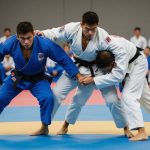Top Strength Training Moves Every UK Football Goalkeeper Should Master
The Importance of Strength Training for Goalkeepers
When it comes to football, the goalkeeper is often the last line of defense, and their role is as crucial as it is demanding. Unlike other players on the field, goalkeepers need a unique blend of strength, agility, and reaction time to perform at their best. Strength training is not just an optional supplement to a goalkeeper’s regimen; it is a necessity.
“Strength and conditioning are essential for soccer players, including goalkeepers, as they enhance performance and reduce the risk of injury,” notes a study on strength and conditioning for soccer players.
In parallel : Key Elements of an Effective Recovery Plan for Injured Athletes in the UK
Here are some key reasons why strength training should be a priority for goalkeepers:
- Injury Prevention: Strengthening the muscles around the joints, particularly in the shoulders, knees, and ankles, can help prevent common goalkeeper injuries.
- Improved Performance: Enhanced strength allows goalkeepers to jump higher, cover more ground, and react faster to the ball.
- Better Decision Making: A physically fit goalkeeper can maintain focus and make better decisions during high-pressure situations.
Core Strength Training Exercises for Goalkeepers
Upper Body Strength
Goalkeepers need strong upper bodies to handle the physical demands of the game, such as diving, catching, and throwing the ball.
Also read : Unlocking Potential: The Transformative Impact of Mindfulness Techniques on Competitive Swimmers in the UK
-
Bench Press:
-
This exercise targets the chest, shoulders, and triceps, all of which are crucial for a goalkeeper’s ability to catch and throw the ball.
-
Sets and Reps: 3 sets of 8-12 reps.
-
Tip: Use a weight that allows you to complete the reps with good form but still challenges you.
-
Pull-Ups:
-
Pull-ups are excellent for building back and arm strength, essential for goalkeepers who need to pull themselves up quickly to catch high balls.
-
Sets and Reps: 3 sets of as many reps as possible.
-
Tip: If you can’t do a full pull-up, start with assisted pull-ups or use resistance bands.
-
Dumbbell Shoulder Press:
-
This exercise targets the deltoids, which are vital for stability and power when diving or jumping.
-
Sets and Reps: 3 sets of 10-15 reps.
-
Tip: Keep your core engaged to maintain balance.
Lower Body Strength
A strong lower body is essential for goalkeepers to jump, sprint, and change direction quickly.
-
Squats:
-
Squats work multiple muscle groups, including the quadriceps, hamstrings, and glutes.
-
Sets and Reps: 3 sets of 8-12 reps.
-
Tip: Keep your back straight and lower yourself until your thighs are parallel to the ground.
-
Lunges:
-
Lunges target the quadriceps, hamstrings, and glutes, and also improve balance and stability.
-
Sets and Reps: 3 sets of 10-15 reps per leg.
-
Tip: Keep your front knee behind your toes and your back knee almost touching the ground.
-
Deadlifts:
-
Deadlifts are a compound exercise that work multiple muscle groups, including the legs, back, and core.
-
Sets and Reps: 3 sets of 8-12 reps.
-
Tip: Keep your back straight and lift with your legs rather than your back.
Plyometric Training for Goalkeepers
Plyometric training, also known as jump training, is crucial for goalkeepers who need to explosively jump to catch high balls or make acrobatic saves.
Box Jumps
- How to Do It: Stand in front of a box or bench, then explosively jump up onto it.
- Sets and Reps: 3 sets of 10-15 reps.
- Tip: Focus on quick turnaround times between jumps to simulate game conditions.
Depth Jumps
- How to Do It: Stand on a box or bench, then jump down and immediately jump up as high as possible.
- Sets and Reps: 3 sets of 10-15 reps.
- Tip: Land softly on the balls of your feet to reduce impact on your joints.
Power Training for Goalkeepers
Power training is about generating force quickly, which is essential for goalkeepers to react to fast-moving balls and make rapid movements.
Medicine Ball Throws
- How to Do It: Hold a medicine ball and explosively throw it forward or upward.
- Sets and Reps: 3 sets of 10-15 reps.
- Tip: Use different types of throws (e.g., forward, upward, rotational) to mimic various game scenarios.
Resistance Band Training
- How to Do It: Use resistance bands to perform exercises like banded squats, lunges, or leg presses.
- Sets and Reps: 3 sets of 10-15 reps.
- Tip: Adjust the resistance level based on your strength and the specific exercise.
High-Intensity Interval Training (HIIT)
HIIT is a training method that involves short bursts of high-intensity exercise followed by brief periods of rest. This type of training is highly effective for soccer players, including goalkeepers.
Example HIIT Session
| Exercise | Duration | Rest Time |
|---|---|---|
| Sprints | 30 seconds | 30 seconds |
| Burpees | 30 seconds | 30 seconds |
| Jump Squats | 30 seconds | 30 seconds |
| Mountain Climbers | 30 seconds | 30 seconds |
| Rest | – | 2 minutes |
- Repeat the cycle: 3-4 times.
- Tip: Warm up thoroughly before starting and cool down afterward to prevent injuries.
Single Leg Training for Stability and Balance
Single leg training is crucial for goalkeepers as it improves stability, balance, and overall lower body strength.
Single Leg Squats
- How to Do It: Stand on one leg and lower yourself into a squat position.
- Sets and Reps: 3 sets of 10-15 reps per leg.
- Tip: Keep your back straight and your core engaged to maintain balance.
Single Leg Deadlifts
- How to Do It: Stand on one leg and bend forward at the hips, keeping your back straight.
- Sets and Reps: 3 sets of 10-15 reps per leg.
- Tip: Focus on slow and controlled movements to avoid losing balance.
Practical Insights and Actionable Advice
Create a Balanced Training Session
A well-rounded training session for goalkeepers should include a mix of strength training, plyometric training, power training, and HIIT.
Example Training Session:
- Warm-up: 15 minutes (light cardio and stretching)
- Strength Training: 30 minutes (upper body and lower body exercises)
- Plyometric Training: 20 minutes (box jumps, depth jumps)
- Power Training: 20 minutes (medicine ball throws, resistance band training)
- HIIT: 20 minutes (sprints, burpees, jump squats)
- Cool-down: 10 minutes (stretching)
Use the Right Equipment
Investing in the right equipment can enhance your training. For example, using a high-quality football like the FORZA GK Reflex Football can improve your concentration and reactions during training sessions.
Seek Professional Guidance
Working with a qualified strength and conditioning coach can help you tailor your training to your specific needs and goals. They can also provide valuable feedback on your form and technique.
Strength training is not just about lifting weights; it’s about building the physical and mental resilience needed to excel as a goalkeeper. By incorporating a variety of exercises into your training regimen, you can improve your performance, reduce the risk of injury, and become a more effective and confident goalkeeper.
As noted by sports medicine experts, “A well-structured strength and conditioning program can significantly enhance a soccer player’s performance and reduce the risk of injury”.
Remember, every training session is an opportunity to improve your skills and move closer to your goal of becoming a top-notch goalkeeper. So, stay committed, stay focused, and always push yourself to be better.











